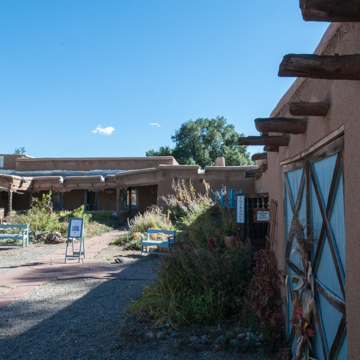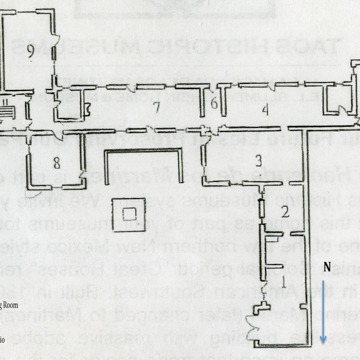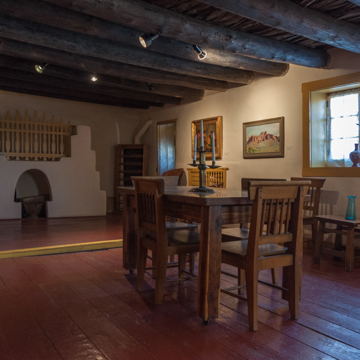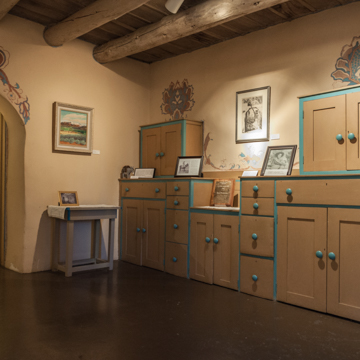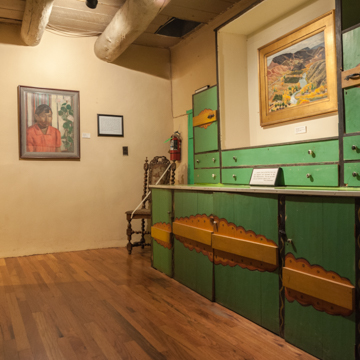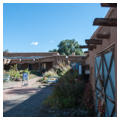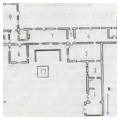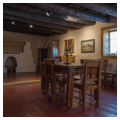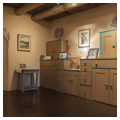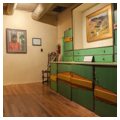You are here
Ernest L. Blumenschein Home
The Ernest L. Blumenschein House was home to a founding member of the Taos Society of Artists. Assembled from multiple historic adobes, the house is a portrait of both the artistic community that gathered in Taos in the first decades of the twentieth century and of Blumenschein’s marriage to Mary Shepherd Greene, who was primarily responsible for its final form and decoration. Located a short distance south of the Taos Plaza, the Blumenschein House now anchors a picturesque winding street lined with galleries that include the nearby Harwood Art Museum.
Ernest Leonard Blumenschein (1874–1960) and Mary Shepard Greene (1869–1958) were academically trained artists with successful careers as commercial illustrators in both New York City and Paris, where they met in 1903 and married in 1905. Blumenschein discovered the Southwest when McClure’s Magazine commissioned him in 1896 to produce a series of illustrations of Arizona and New Mexico. Captivated by the sublime landscapes and the local, especially Native American, cultures, Blumenschein returned to New Mexico in 1898 accompanied by a fellow artist, Bert Geer Phillips.
On the advice of another artist, Joseph Henry Sharp—whom Blumenschein and Phillips had met while studying at the Académie Julian in Paris—they headed for Taos. Their journey to this remote outpost in the Territory of New Mexico, traveling from Denver by horse and buggy across a mountainous landscape, was harrowing: one of their horses strangled in its traces and then a buggy wheel broke. The story of Blumenschein riding into Taos with the broken wheel would be retold many times and made him a local legend in later decades. Just as telling were his revelatory first impressions, which he recalled in 1926 as “a majestic landscape once tortured now calm; the fitness of adobe houses to their tawny surroundings; the vastness and overwhelming beauty of skies… all in beauty of color, vigorous form, ever changing light.”
Blumenschein spent the following decade advancing his career in New York and Paris. Starting in 1910, however, he returned to Taos every year for approximately three months in late summer and fall to paint, his trips funded by the Atchison, Topeka and Santa Fe Railroad in return for illustrations marketing the Southwest. Mary and their daughter, Helen, came for a single, disastrous, and brief visit during a diphtheria epidemic in 1913, but these sabbaticals were otherwise spent alone.
The Taos Society of Artists was informally established in 1912 and officially constituted in 1915. Its focus on painting the landscapes, Native and Hispanic peoples, and adobe buildings of New Mexico was loosely modeled after the earlier regional precedent of the Hudson River School. But the Society was less a school with a shared aesthetic mission than a marketing cooperative whose purpose was to promote, exhibit, and sell the work of its members in the eastern United States. Blumenschein was expelled in 1923, when he refused to continue serving as its secretary. By then, Taos was an internationally recognized art colony and the Society, its objective realized, disbanded in 1927.
In 1919, Mary received a large inheritance following the death of her mother and Blumenschein gave up commercial illustration to devote himself exclusively to painting. That same year, he finally overcame Mary’s resistance to leaving cosmopolitan New York for the wilds of New Mexico. He bought a house on Ledoux Street from his former student, Herbert Dutton, and the family moved to Taos in 1920. While Blumenschein painted, Mary put her career on hold to manage the house.
The four-room core of their adobe house was built between 1797 and 1823, and originally formed an outer part of the fortified plaza of Fernández de Taos (founded in 1796). Two smaller rooms on the front (north) side were combined to make a dining room with a staggered floor. To screen a water heater installed on the upper level in the 1930s, Mary designed a simulated fireplace with a stepped profile evoking Taos Pueblo. At the back (south) side of the house ran a pair of rectangular rooms to either side of a narrow storage room that was repurposed as a water closet. The room directly behind the dining room was turned into a library, with hardwood floors, large windows, a raised ceiling, somber red walls, and built-in bookcases. East of the library, what had been Dutton’s studio became a living room; two false fireplaces installed by Dutton were removed in the 1920s (one was rebuilt in 1989) so that the room could serve as a gallery for Blumenschein’s paintings.
Between 1920 and 1925, the Blumenscheins erected a carriage house on Ledoux Street and purchased two adobe buildings to the east of their house. Dating to circa 1825, these were remade into Helen’s bedroom, called the Blue Room, and Blumenschein’s studio. Mary decorated the Blue Room with a painted built-in cabinet and abstracted floral motifs on the walls. In a further sign of her search for creative outlets, Mary also converted part of the carriage house to serve as a jewelry workshop.
In 1931, a final cluster of purchases and alterations linked the various pieces of the house into a complete if rambling whole. An existing one-room structure between the carriage house and dining room became a compact yet efficient kitchen. A small store beyond the library at the southwest corner of the house was demolished and replaced by a master bedroom and bath, its new construction adopting the adobe walls and ceilings of vigas and aspen latillas of the earlier buildings. Another piece of property alongside Blumenschein’s studio on the east side of the house, with structures dating to circa 1825, was converted into a guest room called the Green Room, a second bathroom, and an L-shaped hallway that connects the Green Room, the Blue Room, and the studio to the living room. Mary designed the painted linen cabinet for this hallway, next to a diminutive green door into her husband’s studio.
Helen Greene Blumenschein gave the house to the Kit Carson Foundation in 1962. Now owned by Taos Historic Museums, this house museum has been returned to its state in the 1930s and is open to the public during regularly scheduled hours.
References
Blumenschein, Helen. Recuerdos: Early Days of the Blumenschein Family. Silver City, NM: Tecolote Press, 1979.
Greenwood, Richard, “Ernest L. Blumenschein House,” Taos County, New Mexico. National Register of Historic Places Inventory–Nomination Form, 1975. National Park Service, U.S. Department of the Interior, Washington, D.C.
Larson, Robert W., and Carole B. Larson. Ernest L. Blumenschein: The Life of an American Artist. Norman: University of Oklahoma Press, 2013.
Luhan, Mabel Dodge. Taos and its Artists. New York: Duell, Sloan and Pearce, 1947.
Writing Credits
If SAH Archipedia has been useful to you, please consider supporting it.
SAH Archipedia tells the story of the United States through its buildings, landscapes, and cities. This freely available resource empowers the public with authoritative knowledge that deepens their understanding and appreciation of the built environment. But the Society of Architectural Historians, which created SAH Archipedia with University of Virginia Press, needs your support to maintain the high-caliber research, writing, photography, cartography, editing, design, and programming that make SAH Archipedia a trusted online resource available to all who value the history of place, heritage tourism, and learning.










